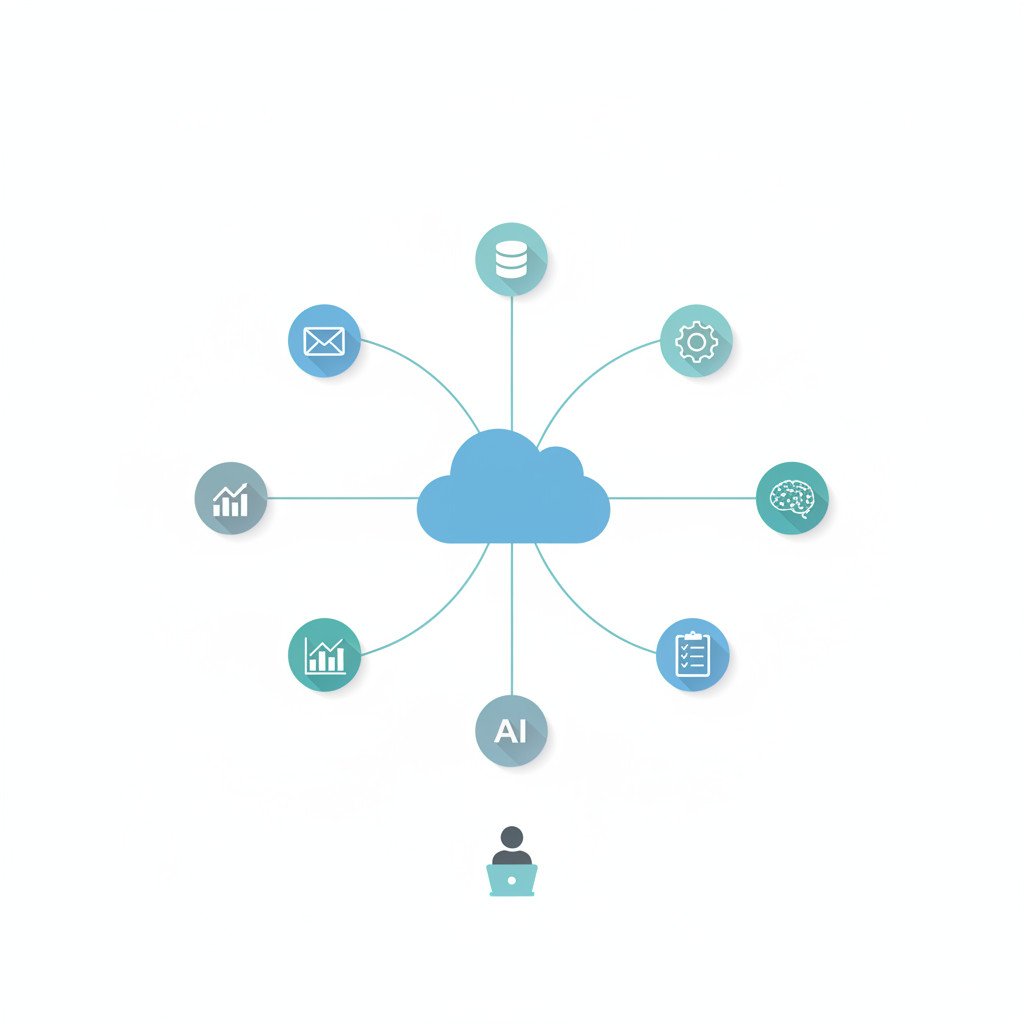Zapier vs Gumloop comparison: Choosing the right automation platform for AI workflows
Choosing between Zapier and Gumloop matters because automation shapes productivity and cost. In this Zapier vs Gumloop comparison we break down differences that matter for businesses and marketers. Zapier has a decade of development and 8,000+ integrations, while Gumloop launched in 2023 with 100+ connected apps and AI first features. Marketers care about integrations, pricing, and AI capabilities.
As a result, you should weigh task based pricing against Gumloop’s credit based model, and consider enterprise needs like SSO, audit logging, and compliance. Zapier offers battle tested uptime and wide ecosystem support, whereas Gumloop focuses on AI automation and built in AI nodes such as Gummie. However, Gumloop can excel for media analysis and custom AI workflows.
For large teams, Zapier’s Tables, Interfaces, and Copilot may speed deployments. Therefore, this comparison will help you choose based on scale, maintenance burden, and cost. By the end, you will know which platform fits enterprise automation, AI orchestration, or fast experimental workflows.

Zapier overview: Zapier vs Gumloop comparison
Zapier leads the market for general purpose automation because it connects thousands of apps. In this Zapier vs Gumloop comparison we focus on Zapier’s scale, reliability, and enterprise features. Marketers, operations teams, and developers rely on Zapier for repeatable workflows and cross platform data sync.
Zapier offers over 8,000 integrations and 400 AI tools, for example Copilot and common LLM connectors. It provides Tables and Interfaces to centralize data and build simple internal apps. Also, Zapier runs scheduled jobs and event driven triggers reliably. Developers can extend integrations with webhooks and the developer platform.
Enterprises get SSO, granular permissions, audit logging, and real time alerts. Zapier promises 99.99 percent uptime and a decade of product maturity. As a result, large organizations trust Zapier with mission critical processes. It also manages most API changes automatically, which reduces integration maintenance.
Common use cases include lead routing, CRM syncs, onboarding workflows, and automated reporting. Because Zapier uses task based pricing, cost scales with automation volume. However, the task model stays transparent, so teams can budget accurately. For teams needing broad connector coverage, Zapier minimizes custom integration work.
Compared to Gumloop, Zapier emphasizes breadth over AI first depth. However, Gumloop focuses on AI automation and built in AI nodes such as Gummie. For a deeper enterprise comparison, read our full analysis. Also explore Zapier for product details and pricing. Explore Gumloop for more information.
Gumloop overview: Zapier vs Gumloop comparison
Gumloop presents itself as an AI first automation platform built for data, media, and complex AI workflows. In this Zapier vs Gumloop comparison, Gumloop stands out for its built-in AI nodes and an assistant named Gummie. Founded in 2023, Gumloop focuses on rapid prototyping and tight AI orchestration. As a result, teams experimenting with LLMs and media analysis find it compelling.
Key features include a library of 100 plus connected apps and custom integration support. Also, Gumloop provides credit based pricing where basic flows cost one credit and complex actions run two to sixty credits. Moreover, it offers SOC 2 and GDPR compliance, admin dashboards, access controls, and audit logging. Because Gumloop includes AI powered nodes, you can extract data, analyze images or video, and run model driven transformations inside flows.
Typical users include startups, marketing agencies, product teams, and media operations that need AI centric automations. For example, content teams use Gumloop to auto tag media and generate summaries. Therefore, teams that prioritize AI processing and fast iteration often prefer Gumloop. However, enterprises requiring thousands of pre built connectors may find Gumloop’s library limiting.
The tradeoffs are clear: Gumloop accelerates AI first workflows but has fewer pre built integrations than Zapier. Also, teams must handle some API change management for custom connectors. Explore Gumloop’s site for product details and pricing at Gumloop to evaluate fit for your use case.
| Feature | Zapier | Gumloop |
|---|---|---|
| Founded | 2011 | 2023 |
| Integrations | 8,000+ apps, 400+ AI tools | 100+ apps with additional custom integrations |
| Pricing Model | Task-based pricing | Credit-based pricing |
| AI Features | Zapier Copilot | Gummie AI assistant and AI-powered nodes |
| Ease of Use | User-friendly UI with automated maintenance | Requires management of some API changes |
| Uptime | 99.99% uptime, supports mission-critical tasks | Reliable with enterprise-level features |
| Enterprise Features | SSO, audit logging, real-time alerts | SOC 2, GDPR compliance, custom admin dashboards |
| Common Use Cases | CRM syncs, lead routing, automated reporting | AI-centric automation, data and media analysis |
| Typical Users | Large enterprises, marketers, developers | Startups, media companies, AI-focused teams |
| Link to Learn More | Explore Zapier | Explore Gumloop |

Pros and cons of Zapier
Zapier remains a default choice for many teams because it combines scale, polish, and reliability. However, every tool has tradeoffs. Below are clear pros and cons drawn from user reviews and expert commentary, with practical notes on how each factor affects business decisions.
Pros
- Massive integration library: Zapier supports 8,000 plus apps, including 400 plus AI tools. As a result, teams rarely need to build custom connectors. This reduces upfront engineering cost and speeds time to value.
- Stable and battle tested: Zapier offers 99.99 percent uptime and over a decade of development. Therefore, enterprises trust it for mission critical workflows and compliance driven processes.
- Enterprise controls and security: Features like SSO, granular permissions, audit logs, and real time alerts appear on enterprise plans. Consequently, IT and security teams can enforce policy without heavy custom work.
- Low maintenance for connectors: Zapier automatically handles many API updates and connector maintenance. Thus, operations teams spend less time fixing broken integrations.
- Copilot and AI orchestration: Zapier Copilot helps nontechnical users build automations from descriptions. Because of this, adoption often increases across marketing and customer success teams.
Cons
- Task based pricing can scale up costs: Zapier charges per task, so heavy automation drives higher bills. Teams with high transaction volumes must forecast costs carefully, or else face budget surprises.
- Complex workflows can become expensive: Multi step automations consume more tasks and therefore more budget. For that reason, some companies split workflows across systems to control spend.
- Learning curve for advanced features: Users note that advanced features require time to learn. However, onboarding resources and templates mitigate the ramp time for most teams.
- Less AI depth than AI first platforms: Although Zapier supports many AI tools, it emphasizes breadth rather than deep, built in AI nodes. Therefore, teams focused on media analysis or model orchestration may prefer an AI centric platform.
In short, Zapier excels when organizations need broad connectivity, reliability, and low connector maintenance. For teams prioritizing deep AI processing, evaluate AI first alternatives alongside Zapier.
Pros and cons of Gumloop
Gumloop brings AI forward in automation workflows, which makes it attractive for teams that prioritize model-driven processes. In this Zapier vs Gumloop comparison we examine strengths and weaknesses based on user feedback and expert analysis. The company focuses on AI nodes, a Gummie assistant, and tight media processing.
Pros
- AI first capabilities: Gumloop includes built-in AI nodes and the Gummie assistant. As a result, teams can extract text, analyze media, and run model-driven transforms inside flows. This reduces the need to chain external AI services manually.
- Strong compliance and admin controls: Gumloop offers SOC 2 and GDPR compliance. Also, it provides admin dashboards, access controls, and audit logging. Therefore, security and legal teams often feel comfortable piloting sensitive AI workflows.
- Fast iteration for AI use cases: Users praise Gumloop for rapid prototyping. For example, marketing and media teams can auto-tag assets and generate summaries quickly. Consequently, time to value often shortens for AI centric projects.
- Flexible custom integrations: While the core library is smaller, developers can add custom connectors. Thus, teams can link niche systems when required without waiting for prebuilt support.
Cons
- Smaller integration library: Gumloop connects to roughly 100 plus apps. In contrast, broad enterprise environments may need more connectors. Therefore, integrating legacy systems can require more engineering effort.
- Credit-based pricing complexity: Gumloop uses credits per flow and action. This model can confuse procurement and finance teams. As a result, forecasting costs for high volume media processing may be harder.
- Maintenance overhead for some APIs: Users report handling API changes for custom connectors. However, teams with internal engineering resources adapt quickly. Still, companies without developer support may face friction.
- Younger platform risk: Founded in 2023, Gumloop has less operational history than mature vendors. Consequently, enterprises must evaluate uptime guarantees and support SLAs closely.
Overall, Gumloop suits startups, media operations, and AI teams that need deep model orchestration. Conversely, large enterprises seeking thousands of prebuilt connectors may prefer a more mature ecosystem.
Conclusion: choosing the right platform and next steps
This Zapier vs Gumloop comparison shows a clear tradeoff between breadth and AI depth. Zapier wins on integrations, uptime, and low maintenance. Gumloop wins on built-in AI nodes, rapid prototyping, and media analysis. Therefore, your choice depends on scale, AI needs, and engineering capacity.
For enterprise teams needing thousands of connectors, predictable task pricing, and mature security controls, Zapier is the safer bet. However, for AI-first projects, media workflows, or quick model experiments, Gumloop often accelerates time to value. Also, consider total cost patterns: task-based pricing scales with volume, while credit pricing can complicate forecasts.
EMP0 complements both platforms by building secure, revenue-focused AI and automation systems under client infrastructure. Visit emp0.com to learn how EMP0 deploys AI-powered growth systems that multiply revenue while keeping data on client infrastructure. For in-depth comparisons and enterprise guidance, see our analysis at this link. Follow EMP0 on Twitter at @Emp0_com for updates and practical tips.
If you are evaluating platforms, start with a pilot that maps key workflows and cost drivers. Then iterate quickly, because the right mix of Zapier, Gumloop, and EMP0 services can unlock scalable AI-driven growth.

